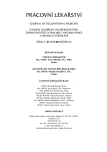Analysis of the impact of sedentary occupation on damaging the back
Authors:
J. Ravasová; I. Bátora
Authors‘ workplace:
Klinika pracovného lekárstva a toxikológie LFUK a FNsP Bratislava, prednosta kliniky doc. MUDr. Igor Bátora, PhD.
Published in:
Pracov. Lék., 62, 2010, No. 2, s. 59-63.
Category:
Original Papers
Overview
Back diseases belong to the most monitored area of locomotor apparatus diseases in clinical occupational medicine. Published papers so far were mostly dealing with diseases of hard workers. Recently, there is a growing amount of white collar workers with sedentary work.
This paper presents the analysis of an anonymous study of PC workers. The questionnaire included questions to consider relevant risk factors for back diseases. Economists, computer programmers, high school teachers and students were asked to fill up the questionnaire. The analyses show that back diseases can be caused not only by risk factors typical for hard work, but also by long sedentary work with the neck pain and low back pain as the most usual diseases. The statistically significant influence of age and psychosocial factors like work satisfaction, salary satisfaction or employment relationship satisfaction on back pain presence was also confirmed.
Key words:
occupational risk factors, back pain
Sources
1. European Agency of Safety and Health at Work: Work-related Low Back Disorders. Summary of Agency report, Facts, 2000.
2. BERGSTRÖM, G. et al. Risk factors for new episodes of sick leave due to neck or back pain in a working population. A prospective study with an 18-month and a three-year follow-up. Occup. Environ. Med., 2007, 64, s. 279–287.
3. ČIERNA, J., BÁTORA, I. Poškodenie chrbtice ako choroba z povolania. Čes. pracov. Lék., 2006, 3, s. 162–164.
4. ELSNER, G., NIENHAUS, A., BECK, W. Zur Frage berufsbedinger degenerativer Diskopathien im Lendenwirbelsäulenbereich. Arbeitsmed. Sozialmed. Präventivmed., 1992, 27, s. 415–422.
5. FELDMAN, J. B. Occupational low back pain disability – evidence based reviews point in a new direction. J. Surg. Orthoped. Adv., 2004, 1, s. 1–41.
6. FEYER, A. et al. The role of physical and psychological factors in occupational low back pain: a prospective cohort study. Occup. Environ. Med., 2000, 57, s. 116–120.
7. GILBERTOVÁ, S. Bolesti zad – úvod do problematiky. Čes. pracov. Lék., 2000, 1, 1, s. 39–40.
8. HLADKÝ, A. Telesné potíže při práci s počítačem. Čes. pracov. Lék., 2000, 1, s. 11–15.
9. HOOGENDOORN, W. E. et al. Systematic review of psychosocial factors at work and private life as risk factors for back pain. Spine, 2000, 25, 16, s. 2114–2125.
10. ILES, R. A.et al. Psychosocial predictors of failure to return to work in non-chronic non-specific low back pain: a systematic review. Occup. Environ. Med., 2008, 65, s. 507–517.
11. JUUL-KISTENSEN, B., JENSEN, C. Self-reported workplace related ergonomic conditions as prognostic factors for musculoskeletal symptoms: the „BIT“ follow up study on office workers. Occup. Environ. Med., 2005, 62, s. 188–194.
12. LÖTTERS, F., BURDORF, A., KRUJPER, J. Model for the work-relatedness of low back pain. Scand. J. Work. Environ. Health, 2003, 6, 29, s. 431–440.
13. KENNEDY, C. et al. Psychosocial factors and low back pain among college students. J. Am. Coll. Health., 2008, 57, 2, s. 191–195.
14. STICHERT, M. Beitrag zur Vermeidung der Berufskrankheit „Bandscheibenbedingte Erkrankungen der Lendenwirbelsäule durch langjähriges Heben und Tragen schwerer Lasten oder durch langjährige Tätigkeit in extremer Rumpfbeugehaltung“. Arbeitsmed. Sozialmed. Umweltmed., 1997, 32, s. 233–234.
15. VAN DIEEN, J. H., ONDE VRIELINK, H. H. E. Evaluation of work-rest schedules with respect to the effects of postural workload in standing work. Ergonomics, 1998, 41, 12, s. 1832–1844.
16. VINGARD, E., NACHEMSON, A. Work-related inluences on neck and low back pain. In NACHEMSON, A., EGON, J. Neck and back pain: The scientific evidence of causes, diagnosis and treatment. Phil. PA. Zippincatt, 2000, s. 97–126.
Labels
Hygiene and epidemiology Hyperbaric medicine Occupational medicineArticle was published in
Occupational Medicine

2010 Issue 2
Most read in this issue
- Analysis of the impact of sedentary occupation on damaging the back
- Asthma bronchiale in the car industry – a case study
- Challenges for preventive occupational medicine and toxicology
- Prevalence of risk factors of cardiovascular diseases in manual workers and application of the SCORE system in occupational medical practice
